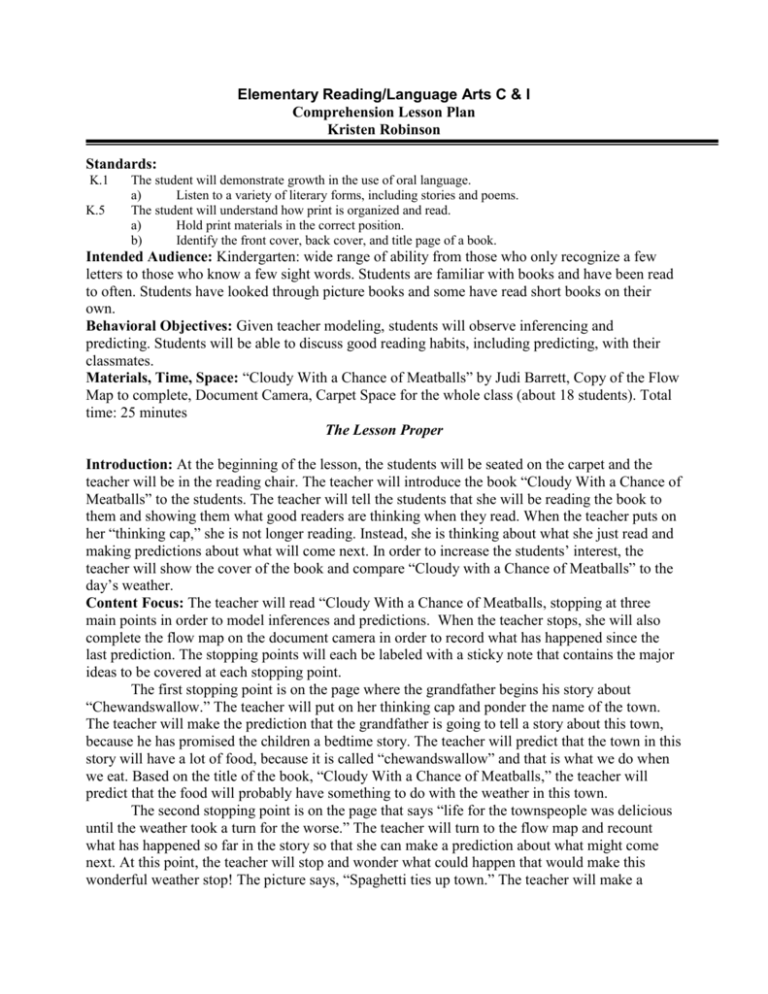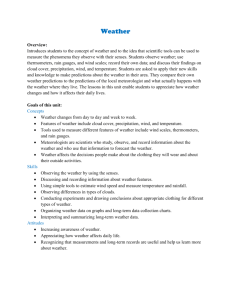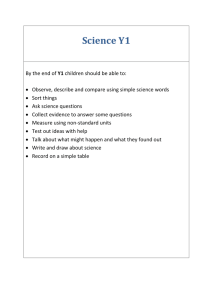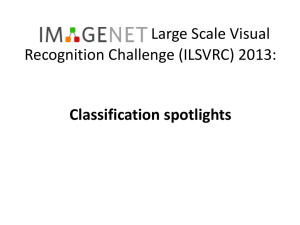Think Aloud Lesson
advertisement

Elementary Reading/Language Arts C & I Comprehension Lesson Plan Kristen Robinson Standards: K.1 K.5 The student will demonstrate growth in the use of oral language. a) Listen to a variety of literary forms, including stories and poems. The student will understand how print is organized and read. a) Hold print materials in the correct position. b) Identify the front cover, back cover, and title page of a book. Intended Audience: Kindergarten: wide range of ability from those who only recognize a few letters to those who know a few sight words. Students are familiar with books and have been read to often. Students have looked through picture books and some have read short books on their own. Behavioral Objectives: Given teacher modeling, students will observe inferencing and predicting. Students will be able to discuss good reading habits, including predicting, with their classmates. Materials, Time, Space: “Cloudy With a Chance of Meatballs” by Judi Barrett, Copy of the Flow Map to complete, Document Camera, Carpet Space for the whole class (about 18 students). Total time: 25 minutes The Lesson Proper Introduction: At the beginning of the lesson, the students will be seated on the carpet and the teacher will be in the reading chair. The teacher will introduce the book “Cloudy With a Chance of Meatballs” to the students. The teacher will tell the students that she will be reading the book to them and showing them what good readers are thinking when they read. When the teacher puts on her “thinking cap,” she is not longer reading. Instead, she is thinking about what she just read and making predictions about what will come next. In order to increase the students’ interest, the teacher will show the cover of the book and compare “Cloudy with a Chance of Meatballs” to the day’s weather. Content Focus: The teacher will read “Cloudy With a Chance of Meatballs, stopping at three main points in order to model inferences and predictions. When the teacher stops, she will also complete the flow map on the document camera in order to record what has happened since the last prediction. The stopping points will each be labeled with a sticky note that contains the major ideas to be covered at each stopping point. The first stopping point is on the page where the grandfather begins his story about “Chewandswallow.” The teacher will put on her thinking cap and ponder the name of the town. The teacher will make the prediction that the grandfather is going to tell a story about this town, because he has promised the children a bedtime story. The teacher will predict that the town in this story will have a lot of food, because it is called “chewandswallow” and that is what we do when we eat. Based on the title of the book, “Cloudy With a Chance of Meatballs,” the teacher will predict that the food will probably have something to do with the weather in this town. The second stopping point is on the page that says “life for the townspeople was delicious until the weather took a turn for the worse.” The teacher will turn to the flow map and recount what has happened so far in the story so that she can make a prediction about what might come next. At this point, the teacher will stop and wonder what could happen that would make this wonderful weather stop! The picture says, “Spaghetti ties up town.” The teacher will make a prediction that there is too much food and the townspeople are having a hard time eating it all, because the spaghetti is in the street. The final stopping point is on the page where the people decide to abandon the town. The teacher will put her cap on and ask where the people would go, and how they would get to a new place. The teacher will ask the students to help her think and make predications. The students will share a few of their predictions with the class. Closure: The teacher will review the flow map with the students at the end of the book in order to summarize what happened. The teacher will then ask the students to tell her what good readers are doing and thinking as they read. The teacher will obtain responses from as many students as possible, and remind students to think about what the teacher was thinking about and doing as she read. The teacher will review predictions at the end by reminding the students where she stopped and thought about what might come next. Evaluation: Formative: The teacher will evaluate the nature of the student responses at the third stopping point and during the closure. Background Information: This lesson is an interactive read aloud that focuses on inferencing and making predictions. The purpose is to model the strategy for the students in order to help them use it as they grow as readers. These students are at a kindergarten level, and therefore are learning how to read and be good readers. After this lesson, students should recognize the importance of making predictions as they read and actively thinking about what might happen next based on the story thus far as well as the pictures. Reflection Overall, this lesson went well and the students were able to see how good readers make predictions and inferences as they read. The thinking cap was an excellent tool, because the students were able to tell when I was reading and when I was thinking about what I had read and making predictions. This was especially important in kindergarten, because many of them cannot read and therefore needed to know the difference. The graphic organizer I used was a flow map, and they have been using flow maps in class. This was an excellent connection, because the students were familiar with the organizer and therefore understood how it was used. They realized that it recorded the sequence of our story and would therefore help us predict what would happen next. This lesson also had a great introduction, because we had just done calendar and checked the weather. The students told me what the weather was like outside, and I compared the weather to the title of “Cloudy With a Chance of Meatballs.” The students were able to see me make a prediction about the story based on our weather, and the fact that we don’t ever have meatballs as a part of our weather. This got the students engaged and ready to listen. The students responded well to this lesson, and they were able to make contributions once I got to the final stopping point. The students had some trouble with calling out, because they were anxious to contribute to my thoughts. I went over this in the beginning, but we had to stop and remind ourselves a few times that we were listening and thinking about the story, and that we needed to keep our hands in our laps for now. Once the students were able to contribute, they had great predictions. The students thought that the townspeople might leave using cars or big busses, which are viable predictions. I asked what the people would do if they were on an island with water all around them, and one student suggested they could make a boat with all of the extra food. This was exactly what the townspeople did, and I have to wonder whether or not the student had read the story before. Another student said that the people would go somewhere with supermarkets, which was a great prediction since too much food was falling from the sky. All of the student predictions were connected to the story, and the students had therefore listened to how I thought about the story before I made a prediction. In order to improve this lesson, I could have the students make their own predictions at the end of the second stopping point, after I had made my predictions. I could then have them do a short journal entry during the third stopping point so that each student had the opportunity to record his or her predictions. After they had made a prediction, I could read the end of the story and have them orally compare their prediction to what happened. This would make the lesson longer, but increase individual student responsibility during the interactive read aloud. Next, I would do another read aloud with these students, but increase the amount of student responsibility. During this read aloud, I would only model during the first stopping point. At the next two stopping points, I would increase student responsibility and have them make predictions. A book such as “If You Give a Dog a Donut” would be good, because the students could predict what the dog would do next. This lesson taught me that it is crucial to model good reading at the kindergarten level, because the students are becoming familiar with texts and learning how to read. This modeling helps the students to think about what they need to do as they are learning to read. The students were able to participate in a discussion about why we need to think about the story as we read and make predictions about what might happen next. This helped the students understand that reading has a purpose and that we can use what we have read so far in order to predict what will happen next. Many of the students get distracted when they read or during read alouds, and this helped them to focus and gave them something specific to think about. It was also crucial for the students to take on the responsibility as I read, because they became even more focused and got to practice the strategy I was showing them.







